Why is There So Much Art Deco Architecture in Asheville, NC?

Asheville, North Carolina has long been known for its vibrant arts scene, great restaurants and breweries, as well as its history. One of the most defining visual features of Asheville, however, is its remarkable collection of Art Deco architecture. With a stunning array of buildings dating back to the 1920s, Asheville boasts one of the highest concentrations of Art Deco structures in the United States. But why is there so much Art Deco architecture in Asheville, NC? Let’s explore the historical context, influential architects, and key preservation efforts that have contributed to Asheville’s enduring Art Deco legacy. As we delve into the story behind these architectural gems, we will also discover the significance of Art Deco in shaping the city’s identity and fostering a lasting appreciation for this unique design movement.
Asheville's Golden Age: 1880 to 1929
The Roaring Twenties and Asheville’s Rapid Growth
The 1920s, often referred to as the Roaring Twenties, was a period of economic prosperity, cultural dynamism, and rapid urbanization throughout the United States. Asheville, too, experienced a remarkable boom during this time. The city’s picturesque setting, pleasant climate, and burgeoning tourism industry led to a surge in population and development. Asheville quickly transformed from a sleepy mountain town to a bustling urban center, known as “The Paris of the South”. Asheville attracted wealthy individuals seeking second homes, entrepreneurs, and artists alike.
Factors Contributing to the Rise of Art Deco Architecture in the City
As Asheville’s economy and population grew, so did the demand for new buildings and infrastructure. The Art Deco style, which emerged in France in the 1920s and quickly gained popularity worldwide, became a natural choice for the city’s architects and developers. Art Deco’s bold geometric shapes, rich colors, and ornate detailing captured the spirit of optimism and progress that defined the era. The style was also well-suited for the modern materials and construction techniques that were becoming increasingly available at the time.
In addition to its aesthetic appeal, Art Deco offered a sense of prestige and sophistication that aligned with Asheville’s aspirations to become a cosmopolitan destination. The city’s leaders and wealthy patrons saw the construction of Art Deco buildings as a way to signal Asheville’s cultural and economic significance, both regionally and nationally.
The Abrupt End of Asheville’s Boom Time in 1929
The stock market crash of 1929 and the subsequent Great Depression brought an abrupt end to Asheville’s golden age. As the city faced financial hardships and mounting debt, many construction projects were halted, and the once-thriving economy came to a standstill. Despite these challenges, Asheville’s commitment to preserving its architectural heritage remained steadfast. The city chose to pay off its depression era debts, with the proper interest, rather than declare bankruptcy. While very noble, the city made its final payment 47 years later in 1976. As a result, many of the iconic Art Deco structures that had been built during the boom years remained standing.
This decision had lasting implications for Asheville’s architectural landscape, as it preserved a snapshot of the city’s prosperous past. Today, the Art Deco buildings that dot Asheville’s downtown area serve as a testament to the city’s resilience and enduring appreciation for the unique design movement that defined its golden age.
Influential Architects and Designers
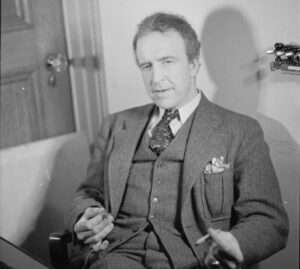
Douglas Ellington
Douglas D. Ellington, a native of Clayton, North Carolina, played a pivotal role in shaping Asheville’s Art Deco landscape. After studying at the École des Beaux-Arts in Paris and working in New York City, Ellington returned to North Carolina in the mid-1920s. His distinctive style, which combined traditional Art Deco elements with regional materials and craftsmanship, had a lasting impact on Asheville’s architectural identity. Among his most notable works are Asheville City Hall, Asheville High School, and the First Baptist Church.
Anthony, "Tony" Lord
Another influential figure in Asheville’s Art Deco history is architect Anthony Lord. Born in 1900, Lord began his career in Asheville and later joined the renowned architectural firm of McKim, Mead & White in New York City. Upon returning to Asheville, Lord incorporated Art Deco elements into his designs, often blending the style with local stone and woodwork to create a distinctively Asheville aesthetic. Lord’s work can be seen in the Kenilworth Inn, the Manor Inn, and the Grove Park Inn addition.

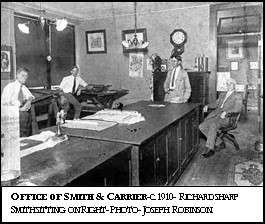
Richard Sharp Smith
Richard Sharp Smith originally came to Asheville to work on the Biltmore Estate. By the time construction was complete, Smith had fallen in love with Asheville and decided to stay. As one of the most prolific architects of the early 20th century in Asheville, Smith’s work can be seen in both residential and commercial buildings throughout the city. Some of his most notable works include the All Souls Cathedral in Biltmore Village, as well as many homes in the Montford and Chestnut Hill neighborhoods. While Smith worked in many architectural styles, his work is most closely associated with timber and pebbledash, as can be seen throughout Biltmore Village.
Charles Parker
Charles N. Parker, who designed the Grove Arcade, had a significant impact on the city’s commercial architecture. His work seamlessly blended functionality with the opulent detailing characteristic of the Art Deco style. In the Grove Arcade, you can see neo-gothic elements combined perfectly with art deco imagery and embellishment.
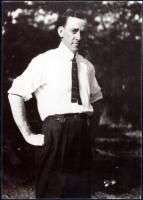
Ronald Greene
Ronald Greene, the architect behind the Jackson Building, was instrumental in introducing the Art Deco style to Asheville’s skyline. His designs showcased the verticality and grandeur of the emerging skyscraper typology, which would come to symbolize the city’s ambition and progress during the 1920s.
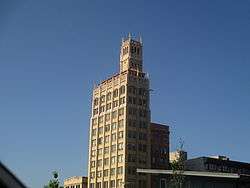
Prominent Art Deco Buildings in Asheville
The central business district in downtown Asheville is full of examples of art deco architecture. Here are a few of our favorites to explore, as you walk around.
Asheville City Hall
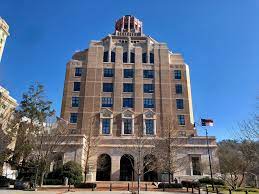
Asheville’s City Hall, completed in 1928, is an architectural masterpiece designed by Douglas D. Ellington. The eight-story building features a distinctive octagonal roof with red and green terra cotta tiles, intricate geometric motifs, and a grand entrance adorned with stylized eagles. The City Hall not only houses government offices but also stands as a symbol of Asheville’s civic pride and its commitment to progress during the city’s golden age.
Asheville High School
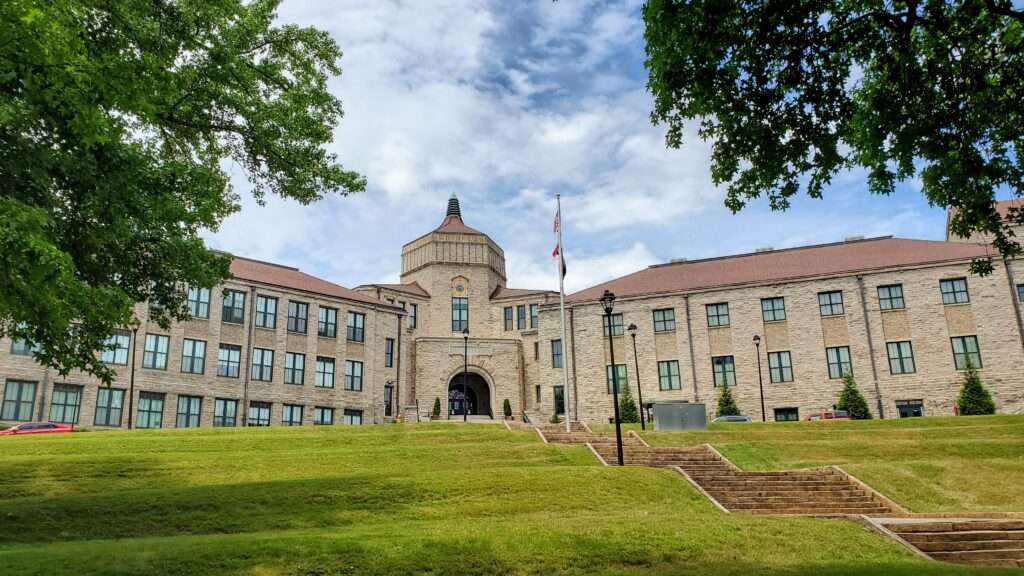
The Asheville High School, completed in 1929, is another example of the city’s dedication to the Art Deco style. Also designed by Ellington, the school building showcases a blend of geometric patterns, ornamental metalwork, and terra cotta detailing. The high school remains an active educational institution, demonstrating the enduring legacy of Asheville’s Art Deco era.
The Grove Arcade
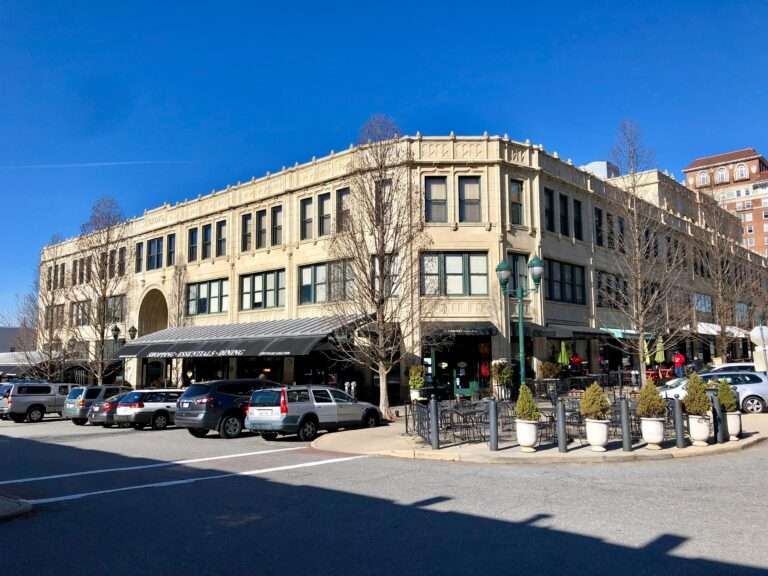
The Grove Arcade, an elegant shopping center completed in 1929, is one of Asheville’s most beloved Art Deco landmarks. Designed by architect Charles N. Parker, the building features an impressive façade with elaborate terra cotta ornamentation, Gothic-inspired arches, and a distinctive glazed terra cotta roof. The Grove Arcade has been painstakingly restored and now houses a vibrant mix of shops, galleries, and restaurants, showcasing the city’s commitment to preserving its architectural heritage.
The S&W Cafeteria Building
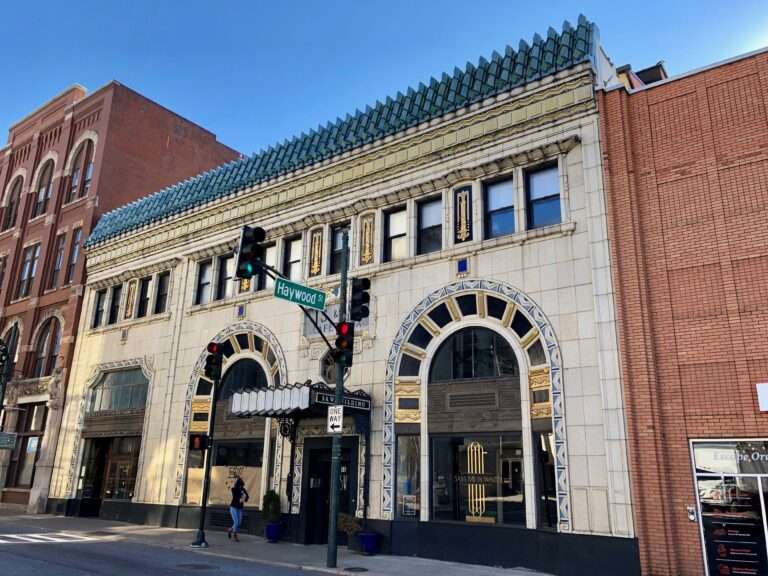
The S&W Cafeteria Building, another Ellington masterpiece, and completed in 1929, was once a popular dining spot for Asheville residents. The building’s eye-catching exterior, featuring a combination of terra cotta and glazed brickwork, draws on the geometric patterns and bold colors characteristic of the Art Deco style. Today, the S&W Building is home to a modern version of a food court, including a satellite tasting room for Highland Brewing.
The First Baptist Church
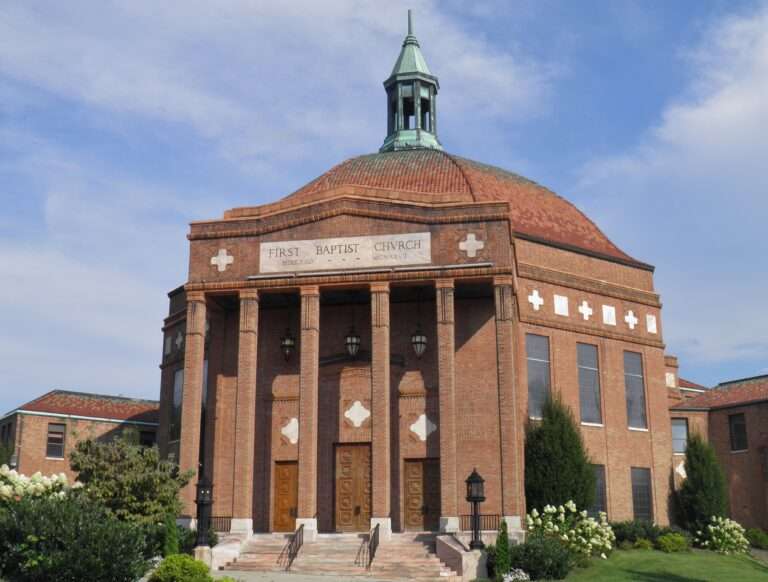
Completed in 1927, the First Baptist Church is a striking example of Art Deco architecture infused with spiritual elements. For this one, Ellington combined the style’s geometric motifs with religious symbolism, creating a unique and awe-inspiring structure. The church’s facade, adorned with stylized crosses and other religious imagery, showcases the versatility of the Art Deco style and its adaptability to various contexts.
The Jackson Building
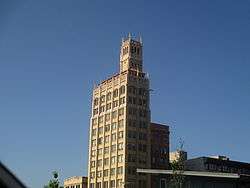
The Jackson Building, completed in 1924, holds the distinction of being Asheville’s first skyscraper. At 15 stories high, this Neo-Gothic structure features Art Deco elements such as the use of geometric patterns and terra cotta ornamentation. Designed by architect Ronald Greene, the Jackson Building’s narrow, towering profile has become an iconic part of Asheville’s skyline, reflecting the city’s ambition and growth during the 1920s.
Preservation and Restoration Efforts
The Role of the Asheville Community in Protecting Art Deco Architecture
The citizens of Asheville have long recognized the importance of preserving their city’s unique architectural heritage. Throughout the 1970s and 80s, many of these buildings were slated for demolition, being seen as either uninhabitable or just in the way of progress. Luckily, community-led organizations and local preservation groups have worked tirelessly to protect Asheville’s historic buildings, with a particular focus on its iconic Art Deco structures. These efforts have played a critical role in maintaining the city’s distinctive character and ensuring that future generations can appreciate the architectural gems that define Asheville’s golden age.
The Work of the Asheville Downtown Association
One of the most prominent organizations dedicated to preserving Asheville’s architectural heritage is the Asheville Downtown Association. Founded in 1987, this non-profit organization has played an instrumental role in advocating for the restoration and adaptive reuse of historic buildings in downtown Asheville, including many of the city’s Art Deco landmarks. Through their efforts, several key structures have been saved from demolition and given new life as commercial, residential, and cultural spaces.
Adaptive Reuse of Historic Buildings: A Sustainable Approach
One of the most effective strategies for preserving Asheville’s Art Deco architecture has been the adaptive reuse of historic buildings. This approach not only protects the architectural integrity of these structures but also ensures their continued use and relevance in a modern context. Many of Asheville’s Art Deco buildings have been repurposed for a variety of uses, including retail, office, residential, and cultural spaces. Examples include the Grove Arcade, which spent years as a government office building before being transformed back into a shopping center, now with luxury condos on the upper floors. The S&W Cafeteria Building has been repurposed as well over the years, and today is home to a variety of restaurants and beverage makers.
Asheville’s commitment to adaptive reuse not only helps maintain the city’s historic character but also promotes sustainability by reducing the need for new construction and the associated consumption of materials and energy. This approach demonstrates the city’s dedication to preserving its past while embracing a forward-thinking and environmentally responsible mindset.
Art Deco and Asheville's Cultural Identity
The Impact of Art Deco Architecture on the City’s Character
Asheville’s rich collection of Art Deco buildings has had a profound impact on the city’s character, setting it apart from other cities in the Southeast. These architectural gems serve as a visual reminder of Asheville’s golden age, a period of optimism, innovation, and rapid growth. The Art Deco structures contribute to the city’s unique sense of place and provide a distinctive backdrop for the quirky city Asheville is today.
Art Deco as an Inspiration for Local Artists and Designers
The Art Deco movement continues to serve as a source of inspiration for artists and designers, today. Many contemporary creatives draw on the geometric forms, bold colors, and intricate detailing characteristic of the style, incorporating these elements into their own work across various mediums. Even without a direct impact on an artist, one can’t help but feel inspired walking among such beautiful buildings.
The Enduring Legacy of Art Deco Architecture in Asheville, NC
Asheville’s unique collection of Art Deco buildings stands as a testament to the city’s rich architectural heritage and the indelible mark left by the city’s golden age. From its rapid growth in the 1920s to the abrupt end of its boom in 1929, Asheville’s Art Deco structures have remained an enduring symbol of the city’s resilience, innovation, and commitment to preserving its past. The architectural gems that define Asheville’s skyline serve not only as a visual reminder of a bygone era but also as an integral part of the city’s contemporary identity and cultural landscape.
The Importance of Preserving the City’s Unique Architectural Heritage
As Asheville continues to grow and evolve, the preservation of its Art Deco heritage becomes increasingly important. Through the efforts of community organizations, local architects, and dedicated citizens, the city has demonstrated a strong commitment to protecting its historic buildings and ensuring their continued relevance in a modern context. By preserving and adaptively reusing these architectural masterpieces, Asheville honors its past while embracing a sustainable and forward-thinking future. The enduring legacy of Art Deco architecture in Asheville, NC, stands as a testament to the city’s unique history and the timeless appeal of this iconic design movement.
Explore Asheville's History With Us!
If you’d like to learn more about Asheville’s past, and its beautiful Art Deco architecture, consider joining us on a Brewery & History Walking Tour. We’ll point out some of our favorite art deco landmarks as we make our way between some of the best breweries in the United States.

